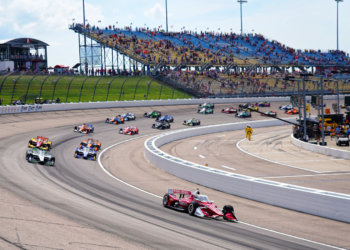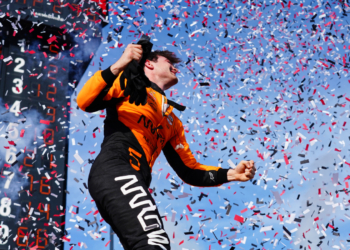Motorsport Week’s team hit the ground running last weekend as they headed south for the sunnier climes of Spain and F1’s ubiquitous testing venue, Circuit de Barcelona-Catalunya. And when it was all over, over-priced greasy burgers and all, senior F1 reporter Phillip Horton sat down and regurgitated his views and verdicts on how each of the 10 teams fared as F1 2017 roared into life.

Scuderia Toro Rosso // Car: STR12
Carlos Sainz Jr. (#55) – 1:23.540 with Mediums on Wednesday – 20th
Daniil Kvyat (#26) – 1:22.956 with Softs on Tuesday – 19th
Easily the new season’s most aesthetically pleasing car has so far proven to be the least productive. Toro Rosso’s launch impressed observers not only through its striking colour scheme, but also with parallels to the car unveiled by champions Mercedes.
But its running was limited throughout the week, with Carlos Sainz Jr. bemused on the opening day as to how Toro Rosso’s rivals were able to rack up the mileage.
Drive-train problems hampered Wednesday’s running, after which the team conceded it would need to adapt its programme and maximise the available track time. That did not happen, as Daniil Kvyat completed just a solitary installation lap before a power unit change ended running for the day, effectively writing off a quarter of the test. Toro Rosso completed only 183 laps, compared to the 556 amassed by Mercedes, and is firmly on the back foot.
Few doubt that the James Key designed STR12 will be firmly in the thick of the midfield battle, and Toro Rosso for now retains confidence, but the team will still be focusing on reliability next week once rivals have moved on to performance.

Haas F1 Team // Car: VF-17
Romain Grosjean (#8) – 1:22.118 with Super Softs on Wednesday – 11th
Kevin Magnussen (#20) – 1:22.204 with Super Softs on Tuesday – 12th
The ‘second season syndrome’ phrase regularly appears in sport but so far Haas has shown encouraging, if not outstanding, form across pre-season testing.
Haas spent last year taking time to recover from problems, due to a lack of experience, but this season they have put that additional knowledge to good use already, with the team recovering from several niggles on day one – including a crash for Kevin Magnussen – to log up some spirited lap times and a lot of mileage.
Romain Grosjean was downbeat after his first day in the car was affected by an issue but, as with Magnussen, his second day in the VF-17 was far more promising. Team boss Guenther Steiner described the teams test as “a lot better” than last season, particularly the reliability, and was in a complimentary mood regarding Ferrari’s power unit.
The primary sticking point, as in 2016, was the brakes, with Haas still not on top of a crucial area of the car. When, or more pertinently if, Haas can address the lingering brake complaints, then it will be in a very good place.

Renault Sport Formula One Team // Car: RS.17
Nico Hülkenberg (#27) – 1:21.791 with Softs on Wednesday – 8th
Jolyon Palmer (#30) – 1:21.396 with Softs on Wednesday – 6th
Renault’s return to Formula 1 was nothing short of a disaster, as it felt the hangover from Lotus’ financial constraints, as it battled with an undeveloped chassis, which had its own power unit shoehorned into the back.
This year’s car was always going to be more refined, the result of increased collaboration between factories at Enstone and Viry. Nevertheless, both Jolyon Palmer and Nico Hülkenberg posted encouraging times for the operation, with their best efforts sufficient for top eight positions on the overall leaderboard, without reverting to Pirelli’s softest compounds.
Renault was also mid-table in terms of the mileage it accrued, with the only drama of note coming when Palmer spun off on the entry to Turn 3 early in Wednesday’s running, a classic case of getting caught out on Medium tyres on a cold track. Renault’s target of finishing fifth in the standings may seem optimistic for a team which scored just three top 10 finishes last year, but this has been a steady start – and it has a far stronger platform on which to build.

Sauber F1 Team // Car: C36-Ferrari
Marcus Ericsson (#9) – 1:21.824 with Super Softs on Wednesday – 9th
Antonio Giovinazzi (#36) – 1:22.401 with Ultra Softs on Thursday – 14th
Sauber is still in a recovery phase after years of financial constraints and therefore hopes aren’t high, particularly when primary 2016 rivals Manor are no longer in the playground.
Sauber’s C36, equipped purposely with a year-old Ferrari power unit, is a tidy package, with a more refined livery than its predecessor. During testing, the C36 ran well most of the time, with Sauber third on the mileage charts, behind Mercedes and Ferrari.
Marcus Ericsson finished ninth overall, aided by Super Soft tyres, while the biggest talking point surrounded Pascal Wehrlein, with the German still recovering from the back injury he sustained at the Race of Champions. Wehrlein was replaced by Ferrari reserve driver, GP2 runner-up Antonio Giovinazzi, with the Italian acquitting himself well both on and off track at short notice.
Giovinazzi had a couple of moments on-track, while the only major problem came when he lost some time on Tuesday morning while Sauber changed the power unit in the C36.
Related: Team-by-team pre-season testing review: Part 1
Related: Team-by-team pre-season testing review: Part 2






